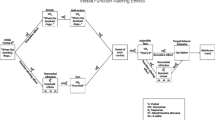Abstract
Echoic, tact, and textual transfer procedures have been proven successful in establishing simple intraverbals (Braam and Poling Applied Research in Mental Retardation, 4, 279–302, 1983; Luciano Applied Research in Mental Retardation, 102, 346–357, 1986; Watkins et al. The Analysis of Verbal Behavior, 7, 69–81, 1989). However, these strategies may be ineffective for some children due to the complexity of the targeted intraverbals. The current study investigated the use of a novel procedure which included a modified chaining procedure and textual prompts to establish intraverbal behavior in the form of telling short stories. Visual prompts and rule statements were used with some of the participants in order to produce the desired behavior change. Results indicated that the procedure was effective for teaching retelling of short stories in three children with autism.




Similar content being viewed by others
References
Braam, S. J., & Poling, A. (1983). Development of intraverbal behavior in mentally retarded individuals through transfer of stimulus control procedures. Applied Research in Mental Retardation, 4, 279–302.
Brainerd, C. J., & Reyna, V. F. (1998). Fuzzy-trace theory and children’s false memories. Journal of Experimental Child Psychology, 71, 81–129.
Finkel, A. S., & Williams, R. L. (2001). A comparison of textual prompts and echoic prompts on the acquisition of intraverbal behavior in a six-year-old boy with autism. The Analysis of Verbal Behavior, 18, 61–70.
Horne, P. J., & Lowe, C. F. (1996). On the origins of naming and other symbolic behavior. Journal of Experimental Analysis of Behavior, 65, 185–241.
Ingvarsson, E. T., & Hollobaugh, T. A. (2011). A comparison of prompting tactics to establish intraverbals in children with autism. Journal of Applied Behavior Analysis, 44, 659–664.
Luciano, M. C. (1986). Acquisition, maintenance, and generalization of productive intraverbal behavior through transfer of stimulus control procedures. Applied Research in Mental Retardation, 102, 346–357.
Michael, J., Palmer, D. C., & Sundberg, M. L. (2011). The multiple control of verbal behavior. The Analysis of Verbal Behavior, 27, 3–22.
Partington, J. W., & Bailey, J. S. (1993). Teaching intraverbal behavior to preschool children. The Analysis of Verbal Behavior, 11, 9–18.
Sautter, R. A., LeBlanc, L. A., Jay, A. A., Goldsmith, T. R., & Carr, J. E. (2011). The role of problem solving in complex intraverbal repertoires. Journal of Applied Behavior Analysis, 44(2), 227–244.
Seiverling, L., Pantelides, M., Ruiz, H. H., & Sturmey, P. (2010). The effect of behavioral skills training on staff chaining of child vocalizations within natural language paradigm. Behavioral Interventions, 25(1), 53–75.
Skinner, B. F. (1957). Verbal behavior. Englewood Cliffs: Prentice-Hall, Inc.
Spooner, F., Spooner, D., & Ulicny, G. (1986). Comparisons of modified backward chaining: backward chaining with leap-aheads and reverse chaining with leap-aheads. Education & Treatment of Children, 9, 122–134.
Sundberg, M. L., & Partington, J. W. (1998). Teaching language to children with autism or other developmental disabilities. Pleasant Hill: Behavior Analysts, Inc.
Tarbox, J., Madrid, W., Aguilar, B., Jacobo, W., & Schiff, A. (2009). Use of chaining to increase complexity of echoics in children with autism. Journal of Applied Behavior Analysis, 42, 901–906.
Vedora, J., Meunier, L., & MacKay, H. (2009). Teaching intraverbal behavior to children with autism: a comparison of textual and echoic prompts. The Analysis of Verbal Behavior, 25, 79–86.
Watkins, C. L., Pack-Teixeira, L., & Howard, J. S. (1989). Teaching intraverbal behavior to severely retarded children. The Analysis of Verbal Behavior, 7, 69–81.
Author information
Authors and Affiliations
Corresponding author
Additional information
Author Note
Amber Valentino is now at Trumpet Behavioral Health in San Jose, CA; Daniel Conine is now at Applied Behavioral Consulting in Atlanta, GA; and Christopher Furlow is now at University of Southern Mississippi.
Appendices
Appendix A—Pages from One of the Stories (“Muffin Bear”) Used with James

Appendix B—Pages from One of the Stories (“Swimming Sam”) Used with Justin

Appendix C—Pages from One of the Stories (“Annie and Albert”) Used with Roger

Rights and permissions
About this article
Cite this article
Valentino, A.L., Conine, D.E., Delfs, C.H. et al. Use of a Modified Chaining Procedure with Textual Prompts to Establish Intraverbal Storytelling. Analysis Verbal Behav 31, 39–58 (2015). https://doi.org/10.1007/s40616-014-0023-x
Published:
Issue Date:
DOI: https://doi.org/10.1007/s40616-014-0023-x




